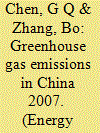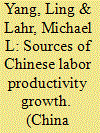|
|
|
Sort Order |
|
|
|
Items / Page
|
|
|
|
|
|
|
| Srl | Item |
| 1 |
ID:
098689


|
|
|
|
|
| Publication |
2010.
|
| Summary/Abstract |
Greater use of renewable energy is being aggressively promoted to combat climate change by the Chinese government and by other governments. Agricultural straw is the kind of renewable energy source that would become a pollution source if it is not well utilized. We select the Shiliquan straw-based electricity generation project in Shandong Province, China as a case and assess environmental externalities of straw utilization in power plants by using life-cycle analysis. Results show that straw-based electricity generation has far fewer greenhouse gas (GHG) emissions than that of coal-based electricity generation. Improvement in the energy efficiency of equipment used for straw's pretreatment would lead to a decrease of GHG emissions and energy consumption in the life-cycle of straw-based electricity generation. In case 400 million tonnes of wasted straw in China could be used as a substitute for 200 million tonnes of coal, annually the straw 291 Terrawatt hours (TWh) of electricity could be generated, resulting in an annual total CO2 emissions savings of 193 million tonnes. Straw-based electricity generation could be a high-potential alternative for electricity generation as well as an incentive for utilizing wheat straw instead of burning it in the field.
|
|
|
|
|
|
|
|
|
|
|
|
|
|
|
|
| 2 |
ID:
158443


|
|
|
|
|
| Summary/Abstract |
The global financial turmoil of 2008 has resulted in the curtailment of military expenditure in most western countries. At a sub-regional-level reductions in the level of activity at a major military facility can have significant economic impact. In the light of this, the paper has two objectives: to analyse the impact of the decision to terminate naval shipbuilding at the United Kingdom’s Portsmouth Naval Base; and, for illustrative purposes, to examine the possible economic consequences of further contraction at the facility. In pursuit of these aims, it is necessary to establish the output, income and employment generated by the base using a bespoke input–output model. The methodology employed can, with appropriate adjustments, be utilised in other military or civilian contexts.
|
|
|
|
|
|
|
|
|
|
|
|
|
|
|
|
| 3 |
ID:
091701


|
|
|
|
|
| Publication |
2009.
|
| Summary/Abstract |
This paper aims at developing an integrated approach for estimating the employment benefits associated with power-generation technologies. The proposed approach exploits the input-output methodology for estimating the direct, indirect and induced employment effects associated with the energy project in question, as well as two different valuation techniques, namely the "opportunity cost of labour" approach and the "public expenditures" approach, for expressing these effects in monetary terms. This framework has been implemented to estimate the employment benefits resulting from the development of a lignite-fired and a natural gas-fired power plant in Greece, taking into account all the stages of the corresponding fuel cycles that are undertaken domestically. The results of the analysis clearly show that lignite-fired electricity generation results in significant employment benefits amounting to 2.9-3.5 €/MWh in the basic scenario. On the other hand, the employment benefits associated with the examined natural gas unit were estimated at 0.4-0.6 €/MWh in the basic scenario. It is also worth mentioning that the significant environmental externalities of the lignite-fired electricity in Greece that have been presented in a number of studies can only be partially compensated by the estimated employment benefits.
|
|
|
|
|
|
|
|
|
|
|
|
|
|
|
|
| 4 |
ID:
098692


|
|
|
|
|
| Publication |
2010.
|
| Summary/Abstract |
For greenhouse gas (GHG) emissions by the Chinese economy in 2007 with the most recent statistics availability, a concrete inventory covering CO2, CH4, and N2O is composed and associated with an input-output analysis to reveal the emission embodiment in final consumption and international trade. The estimated total direct GHG emission amounts to 7456.12 Mt CO2-eq by the commonly referred IPCC global warming potentials, with 63.39% from energy-related CO2, 22.31% from non-energy-related CO2, 11.15% from CH4 and 3.15% from N2O. Responsible for 81.32% of the total GHG emissions are the five sectors of the Electric Power/Steam and Hot Water Production and Supply, Smelting and Pressing of Ferrous and Nonferrous Metals, Nonmetal Mineral Products, Agriculture, and Coal Mining and Dressing, with distinctive emission structures. The sector of Construction holds the top GHG emissions embodied in both domestic production and consumption, and the emission embodied in gross capital formation is prominently more than those in other components of the final consumption characterized by extensive investment in contrast to limited household consumption. China is a net exporter of embodied GHG emissions, with emissions embodied in exports of 3060.18 Mt CO2-eq, in magnitude up to 41.04% of the total direct emission.
|
|
|
|
|
|
|
|
|
|
|
|
|
|
|
|
| 5 |
ID:
147494


|
|
|
|
|
| Summary/Abstract |
As the most knowledge-intensive industrial sectors, China’s defense industries are developing very fast. The present paper will explore the contribution of China’s defense innovation to its economic growth. Cobb–Douglas production function, integrating defense and non-defense stock in knowledge, is applied during the course. In addition, an input–output analysis of defense equipment procurement was done. Positive effect of China’s defense innovation on economic growth has been revealed by comparing the results from the two methods. And some suggestions are made to strengthen the effect.
|
|
|
|
|
|
|
|
|
|
|
|
|
|
|
|
| 6 |
ID:
150435


|
|
|
|
|
| Summary/Abstract |
Over the period between 1990–1 and 2012–3, fossil fuel use on farms has risen and its indirect use in farming, particularly for non-energy purposes, is also growing. Consequently, both energy intensity and fossil fuel intensity are rising for Indian agriculture. But, these are declining for the aggregate Indian economy. Thus, revision of fossil fuel prices acquires greater significance for Indian agriculture than for rest of the economy. There are significant differences across crops. The crop-level analysis is supplemented by an alternative approach that utilizes a three-sector input–output (I–O) model for the Indian economy representing farming, fossil fuels, and rest of economy. Fossil fuels sector is assessed to portray, in general, strong forward linkages. The increase in total cost of farming, for a given change in fossil fuel prices, is estimated as a multiple of increase in direct input cost of fossil fuels in farming. From the three-sector aggregated economy this multiple was estimated at 3.99 for 1998–9. But it grew to 6.7 in 2007–8. The findings have stronger ramifications than commonly recognized, for inflation and cost of implementing the policy on food security.
|
|
|
|
|
|
|
|
|
|
|
|
|
|
|
|
| 7 |
ID:
181463


|
|
|
|
|
| Summary/Abstract |
We analyse the relationship between the economic structure and CO2 emissions from fossil sources for Ecuador, a small developing country that exports raw materials. We use an input–output method to identify the relevant economic sectors in CO2 emissions. Sectoral emissions are decomposed into an own component (emitted directly by its productive process) and an induced component (induced by its interrelation with other sectors). We use the input–output table for 2013 and construct a highly disaggregated vector of CO2 emissions based on fossil energy consumption. The results show that 19 economic sectors (from a total of 71) are relevant in CO2 emissions, of which 8 are classified as key sectors: transportation, refined petroleum, crude oil, electricity, trade services, construction, public administration services and telecommunication services. Despite the last four sectors represent only 9.8% of direct CO2 emissions, they are indirectly responsible for 27.1% of total emissions due to their production chains. Our research orientates effective mitigation policy, as it makes possible to determine which sectors, with a high own component of emissions, require measures such as technological improvements and best practices, and which sectors, with a high induced component of emissions, require intersectoral policies, depending on their supply or demand linkages.
|
|
|
|
|
|
|
|
|
|
|
|
|
|
|
|
| 8 |
ID:
101157


|
|
|
|
|
| Publication |
2010.
|
| Summary/Abstract |
We decompose labor productivity growth from 1987 to 2005 by examining six partial factors (both supply and demand): changes in value-added coefficients, labor inputs, shares of sectoral demands that are fulfilled domestically, input mix, and the intra-sectoral shares and intersectoral mix of final demand. Our analysis confirms that simply by virtue of its size and extremely low level of labor productivity, China's farm sector continues to weigh heavily in China's overall economic advances. Labor savings have levied the largest influence on the labor productivity on all sectors across all three study subperiods. We find that this transition is highly correlated with capital deepening that accompanies China's opening up process. Still, changes in the intra-sectoral shares and the intersectoral mix of China's final demand also have become quite strong, especially in recent periods. Due to ever-increasing competitive pressures as China continues to open, changes in industries value-added coefficients have tended to counteract some of the positive benefits of labor savings for most sectors. The effects on changes in labor productivity of technology change and changes in the use of imports have been comparatively negligible and any variation in their sectoral effects have been waning over time.
|
|
|
|
|
|
|
|
|
|
|
|
|
|
|
|
|
|
|
|
|